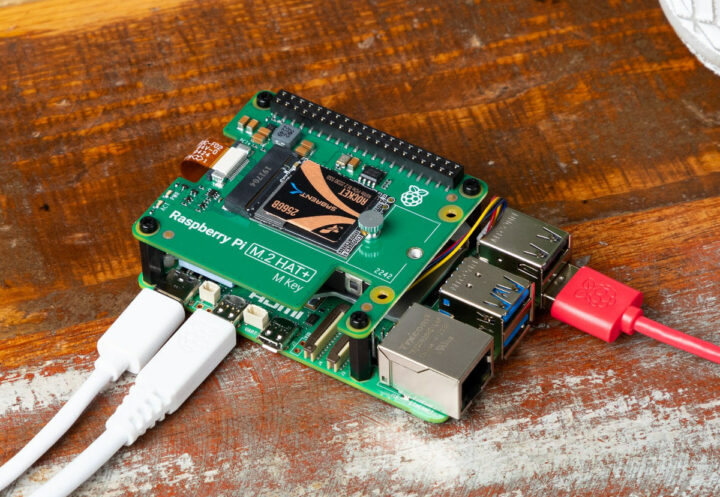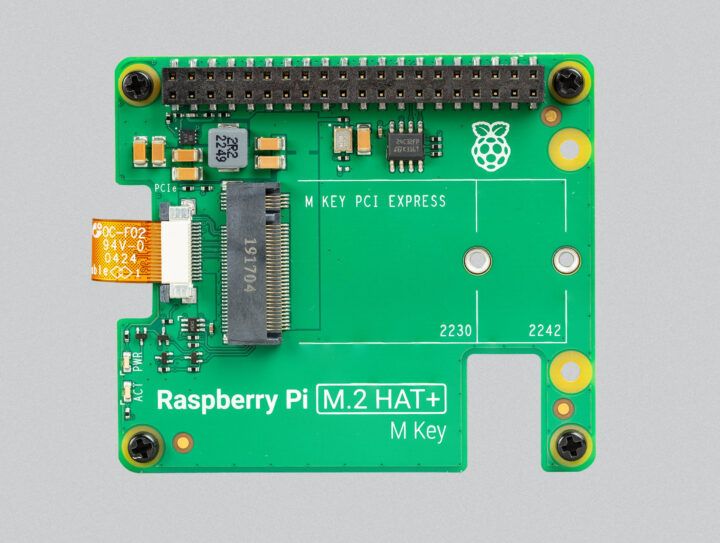The official Raspberry Pi M.2 HAT+ is finally out for $12. The add-on board allows users to connect M.2 M-key peripherals, mainly NVMe SSDs, but also AI accelerators, to their Raspberry Pi 5 leveraging the PCIe connector on the(relatively) new SBC.
We have to stress “official” because it’s been possible to do the exact same thing with third-party boards from PineBerry (now PineBoards), Waveshare, Pimoroni, and Geekworm for about half a year. I also had the opportunity to review the GEEKWORM X1001 and Waveshare M.2 PCIe HAT+ with Cytron MAKERDISK SSDs last month. But let’s have a look at what the official Raspberry Pi M.2 HAT+ has to offer.
Raspberry Pi M.2 HAT+ M Key specifications:
- M.2 M-key socket for 2230 or 2242 modules
- Single-lane PCIe 2.0 interface (500 MB/s peak transfer rate) routed via Raspberry Pi PCIe FFC connector. (Note: PCIe 3.0 should also work fine on most Raspberry Pi 5 boards up to 800MB/s+, but this is not officially guaranteed).
- Supplies up to 3A to connected M.2 devices
- Expansion – 40-pin female/male header to extend the Raspberry Pi 5 GPIO header
- Misc – Power and activity LEDs
- Dimensions
- Conforms to the Raspberry Pi HAT+ specification
- Compatible with Raspberry Pi 5 Active Cooler.
The official Raspberry Pi M.2 HAT+ (M Key) board ships with a ribbon cable a 16mm GPIO stacking header, four threaded spacers, eight screws, and a knurled double-flanged drive attachment screw to secure and support the M.2 peripheral. The installation is straightforward, and you should make sure you have the latest firmware.

Those commands may not be necessary if you have purchased a Raspberry Pi 5 recently, but in any case, they won’t hurt:
|
1 2 3 4 |
sudo apt update && sudo apt upgrade sudo rpi-eeprom-update sudo raspi-config sudo rpi-eeprom-update -a |
I had to run those on my “September 2023” Raspberry Pi 5 to enable booting from the NVMe SSD. You’ll find more details, instructions to get started, and the PDF schematics on the documentation website.
Great! But what took so long? Raspberry Pi explains they wanted to finalize the specifications of the 16-pin FFC connector and the new HAT+ form factor (preview for both released in December 2023), as there were still a few unresolved questions related to two “spare” pins initially carrying I2C signals, but finally used for power enable and board detect/wake signal. Some utilities (EEPROM utils) also had to be updated, and they tested a wide range of NVMe drives and other peripherals to investigate and solve various issues we found. They even got one SSD manufacturer to develop a fix for one of their SSDs (sadly and unsurprisingly they won’t say who).
Anyway, the good news is that the Raspberry Pi M.2 HAT+ Key M is now available from resellers for $12 plus taxes and shipping. Another somewhat related good news is that booting is now supported by the firmware on some HAT+ boards with a PCIe switch. This does not apply to the new M.2 HAT+ we’ve covered today, but several HAT with multiple drives or multiple functions such as the Geekworm X1004 with two M.2 sockets based on ASMedia ASM1182e switch, should now be able to boot Raspberry Pi OS or any other compatible operating system provided the specific PCIe switch is supported by the firmware.

Jean-Luc started CNX Software in 2010 as a part-time endeavor, before quitting his job as a software engineering manager, and starting to write daily news, and reviews full time later in 2011.
Support CNX Software! Donate via cryptocurrencies, become a Patron on Patreon, or purchase goods on Amazon or Aliexpress






Yay I guess…that should have been available day one though
Would it fit any case ?
It might fit into the official case without the fan, but not 100% sure. You’d probably need the active cooler too.
One that works for sure is the one from Hackergadgets and they also reuse the fan from the official case.
https://www.cnx-software.com/2024/05/07/hackergadgets-nvme-hat-for-raspberry-pi-5-fits-in-the-official-case-keeps-the-fan/
Thanks
User comment on CNX Software’s Facebook account about the Pi M.2 HAT+:
What is the difference between his product and Waveshare’s products?
(Waveshare Pcie to m.2 hat+)Which is better?